PDF Attached
US
GDP Annualized (Q/Q) Q4 A: 6.9% (exp 5.5%; prev 2.3%)
US
Initial Jobless Claims Jan-22: 260K (exp 265K; R prev 290K)
US
Durables Goods Orders Dec P: -0.9% (exp -0.5%; R prev 3.2%)
The
soybean complex rallied while grains closed lower, despite good export sales for all-wheat and corn. US soybean product shipments per USDA were excellent. The USD traded sharply higher. Natural gas rallied which pressured new crop corn.
![]()
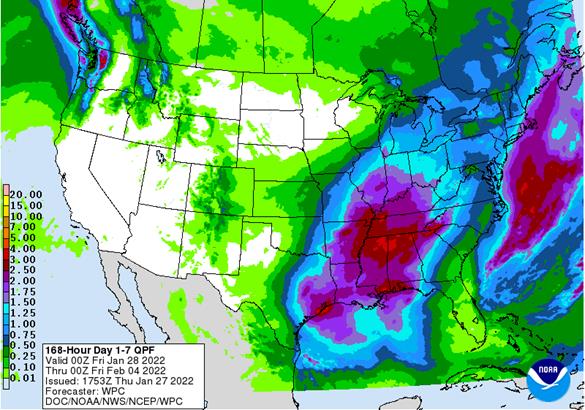
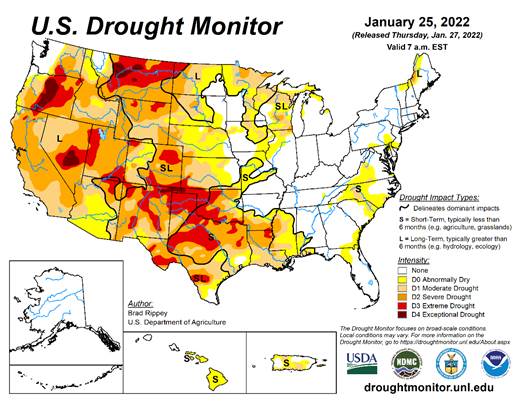
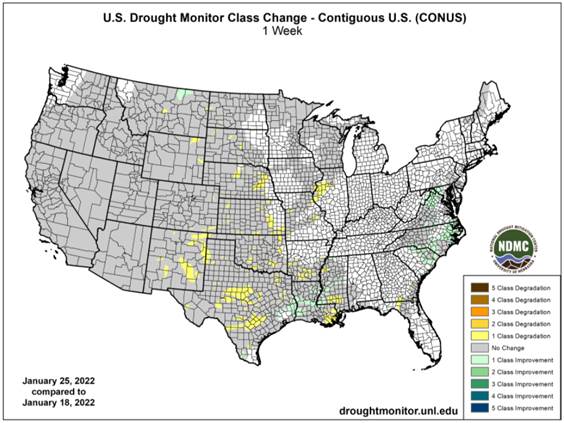
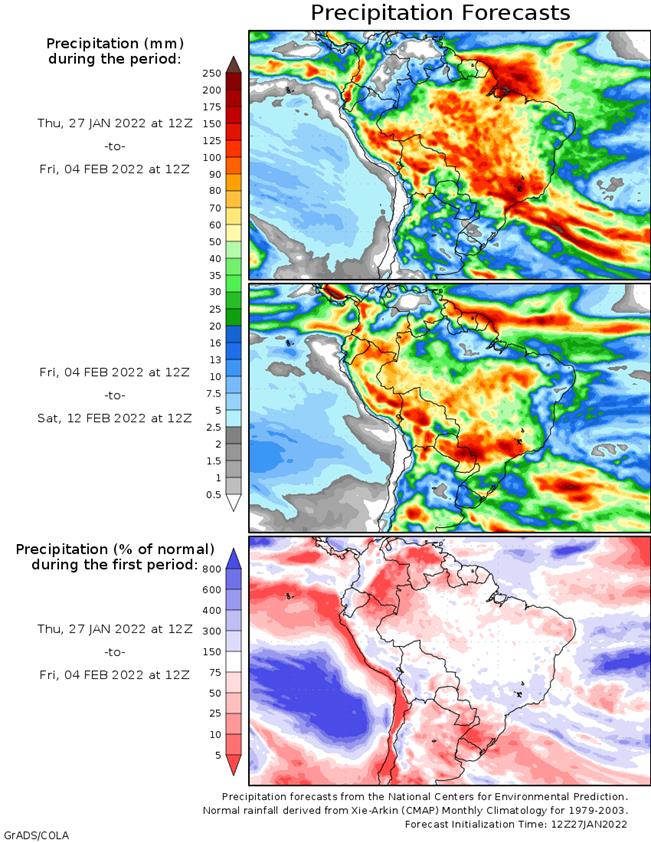
World
Weather Inc.
WEATHER
EVENTS AND FEATURES TO WATCH
- Flooding
is expected in northern Parana and Sao Paulo Friday through Monday as rainfall of 4.00 to more than 8.00 inches results - The
region was drier biased earlier in the growing season and the moisture will help improve deep soil moisture and water supply - Some
improvement in the water flow along the Parana River should be expected, but the river will not come back to “normal” levels - Flooding
could negatively impact soybeans readying for harvest and will certainly delay fieldwork through the coming week - Sugarcane
may sit in standing water for a while which might not be best for the crops, but the region’s excess moisture should slowly drain away in the following week - Minor
coffee production areas impacted by the flooding rain should not be seriously impacted, but less rain might eventually be welcome - Excessive
heat in northeastern Argentina, Paraguay and southwestern Brazil should be coming to an end for a while - The
region has seen upper 90- and 100-110 degree Fahrenheit heat for nearly two weeks and the region also experienced ten days of excessive heat in late December - The
heat and dryness has crippled most crops in the region especially Paraguay - Relief
from the heat will be welcome and a little rain is expected too, but production will not be restored for many summer crops - A
Safrinha crop of corn might be attempted if enough rain falls, but only temporary improvements in topsoil moisture are expected - Argentina
will experience net drying for a little while - The
bottom line for the bulk of corn, soybean, sorghum, sunseed and peanut production areas should be good during the next week to ten days with alternating periods of rain and sunshine - Subsoil
moisture is improving after recent rain has been percolating downward through the soil after the topsoil became saturated earlier in the past week - Argentina
still has a good chance for seeing another high pressure ridge during the middle part of February, but its impact may not be as great on the nation as that of earlier this month - U.S.
hard red winter wheat areas will have a good chance for snow and a little rain briefly during mid-week next week - The
precipitation will help boost topsoil moisture, but the status of drought is unlikely to change - Southwestern
portions of the Plains will not get significant amounts of moisture - Florida
citrus and some sugarcane areas will experience frost and freeze conditions Sunday morning - The
impact on citrus and sugarcane should be low - Most
of the 2021 cane has been harvested, but a little late season fieldwork remains to be done - Sugarcane
will be burned back by frost and freezes, but the cold will not be serious enough to permanently harm crops - Citrus
trees will see low temperatures of 27 to 34 degrees Fahrenheit with frost possible throughout the production region - Freezes
should be most significant in the northern counties of central Florida’s primary production region - The
duration of cold is not likely to be long enough to permanently harm trees and citrus fruit should be protected by irrigation systems and other means to keep groves warm during the coldest night and morning - There
is some potential for a few extreme lows of 25-26, but it is not likely that there will be much impact other than leaf damage - Blossom
buds for the 2022-23 crops should not be permanently harmed and unharvested fruit should be protected by the short duration of the coldest conditions and by irrigation systems producing ice around much of the fruit to insulate it from the coldest conditions - Monday
morning will also be cool, but less threatening - California
and the far western U.S. will experience limited precipitation during the next ten days the lack of moisture will maintain concern over drought, although there is still more time for improved rainfall later in the year - Eastern
U.S. weather will become more active once again next week and there will potential for heavy to excessive precipitation in a part of the northern Delta, Tennessee River Basin and lower eastern Midwest - The
region will be closely monitored for possible flooding - Some
rain will also impact the southeastern states - Atlantic
Coast storm Friday and Saturday will producing strong wind and some heavy rain and snow along the northern half of the U.S. Atlantic Coast.
- Coastal
areas of New England will be most impacted by blizzard conditions - Snow
accumulations of 4-9 inches will occur in eastern Massachusetts while 2 to 6 inches occurs farther to the south into Delaware - Snowfall
of 8 to 20 inches will occur along the coast of Maine and in southeastern Quebec - Blizzard
conditions are expected especially in New England - Eastern
U.S. Midwest and Atlantic Coast States will experience cold weather through weekend
- Another
round of positive and negative single digit lows will occur in the Midwest Saturday morning with similar conditions in the northeastern and middle Atlantic Coast states Sunday - West
Texas is not expecting much precipitation for a while - Southwestern
Canada’s Prairies and the northwestern U.S. Plains will get some snowfall in the next couple of weeks, but moisture totals will continue lighter than usual away from the Rocky Mountains - Southeastern
Canada temperatures this morning were brutally cold again with lows in the -30s and -20s except in Quebec
- Extreme
lows below -40 Fahrenheit occurred north of crop areas in Quebec and northeastern Ontario Wednesday morning
- South
Africa weather will include increasing scattered showers and thunderstorms periodically during the next ten days favoring fieldwork and crop development - The
environment should help improve crop conditions in those areas that became too wet for a while earlier this month and last - Temperatures
will be near to above average - Australia’s
eastern agricultural areas will experience periods of rain and sunshine over the next two weeks with mostly seasonable temperatures - Queensland
cotton and sorghum areas will get most of their rain in the second week of the forecast and eastern cotton and sugarcane areas should become wettest - New
South Wales will see a better distribution in rainfall favoring improved dryland summer grain, cotton and livestock conditions - India’s
weather is trending drier again - Recent
rain has been ideal for winter crops moving into reproduction and the outlook is good for high yields this year especially if some timely rain falls in February and temperatures do not turn hot - The
outlook favors near to below-average temperatures and an opportunity for rain later in February
- Showers
in the coming two weeks will occur mostly in and near Nepal as well as in a few far northern crop areas - Eastern
China’s weather will be typical for this time of year over the next couple of weeks with waves of rain and a little snow occurring across the east-central and southeastern parts of the nation favoring the Yangtze River Basin - Rainfall
of 2.00 to 5.00 inches will occur from near the Yangtze River southward to the coast during the next ten days with a few greater amounts possible
- Some
significant snow may impact northern parts of the Yangtze River Basin as well - Sufficient
moisture is expected to maintain a very good outlook for rapeseed and winter wheat - Local
flooding is possible, but crop damage is not very likely - Limited
moisture in the north is not unusual for this time of year and the soil is favorably rated for the start of spring - There
are no areas of drought in eastern China - Concern
has been rising over the lack of precipitation in Xinjiang this winter and especially the mountains which may cut into spring runoff potential for irrigated summer crops - CIS
weather over the next two weeks will continue offering periods of snow and some rain in the south with temperatures near to below average west of the Ural Mountains this week and then warmer again next week - The
bottom line is favorable for most winter crops which have not encountered much winterkill this year - Concern
remains for low groundwater in southern parts of Russia’s New Lands and northern Kazakhstan
- Similar
conditions are present in central and eastern Ukraine and Russia’s Volga Basin, but there is a deep accumulation of snow that should improve that situation in the spring snow melt season - Western
Europe will continue to experience less than usual precipitation during the next week while eastern Europe gets enough moisture to maintain favorable snow cover and soil moisture - A
boost in precipitation will soon be needed in Spain, Portugal and neighboring areas - Some
forecast model runs overnight suggested Spain, France and Portugal may get some rain in the second week of the outlook
- Eastern
Europe precipitation will continue periodically while temperatures are near to above normal in this coming week - Less
precipitation is expected next week - Middle
East snow cover is more widespread than usual reaching across most of Turkey and into western and northern Iran - Then
moisture will be good for winter crops when warming melts the snow - North
Africa is unlikely to see much precipitation for a while, although a few showers are expected infrequently
- Drought
remains most serious in southwestern Morocco, but dryness is also a concern in northwestern Algeria and in a few northeastern Morocco locations - Ethiopia
has been seasonably dry recently while light showers occur in Uganda and southwestern Kenya - Tanzania
has been and will continue wettest which is normal for this time of year in east-central Africa
- Little
change is expected in these patterns through the next two weeks - West-central
Africa was dry and seasonably warm Tuesday with highs in the lower to middle 90s Fahrenheit - Similar
conditions were expected over the next ten days - Indonesia,
Malaysia and Philippines rainfall should occur routinely over the next two weeks support most crop needs.
- No
excessive rainfall is expected - Northern
Vietnam will receive some scattered showers for a while this week - Precipitation
totals will be light, but the region has seen an abundance of rain recently - Showers
will develop southward in the remainder of Vietnam, Thailand and Cambodia during the weekend and especially next week - The
precipitation will be light - Today’s
Southern Oscillation Index is +0.83 - The
index may move higher during the next seven days - New
Zealand rainfall will continue lighter than usual this week and then increase next week - The
nation has been drying out in recent weeks - Temperatures
have been seasonable and will continue that way - Mexico
will experience slightly cooler than usual weather with a few showers in the south and east during the coming week - Northern
and some western areas in the nation will be drier than usual - Central
America precipitation will be greatest along the Caribbean Coast , but including a fair amount of Panama and Costa Rica - Guatemala
will also get some showers periodically - Western
Colombia Ecuador and Peru rainfall may be greater than usual in the coming week
- Western
Venezuela will soon begin receiving rain once again after a bout of dryness - The
remainder of Venezuela will remain dry
Source:
World Weather Inc.
Bloomberg
Ag Calendar
Thursday,
Jan. 27:
- USDA
weekly net-export sales for corn, soybeans, wheat, cotton, pork and beef, 8:30am - Paris
Grain Day conference, Jan. 27-28 - Port
of Rouen data on French grain exports
Friday,
Jan. 28:
- ICE
Futures Europe weekly commitments of traders report, ~1:30pm - CFTC
commitments of traders weekly report on positions for various U.S. futures and options, 3:30pm - U.S.
cattle on feed, 3pm
Source:
Bloomberg and FI
Correction
to data published yesterday by trade sources. We compared the changes to their November figures. They had updated plantings in December.
IHS
Markit 2022 US plantings via trade sources
Corn
91.489 vs. 91.578 previous -0.089 compared to 93.357 for 2021
Soy
87.805 vs. 88.815 previous -1.010 compared to 87.195 for 2021
All
48.157 vs. 48.603 previous -0.446 compared to 46.703 for 2021
Winter
34.397 vs. 34.397 Same as USDA Jan compared to 33.648 for 2021
Spring
12.010 vs. 12.720 previous -0.710 compared to 11.420 for 2021
Durum
1.750 vs. 1.850 previous -0.100 compared to 1.635 for 2021
Cotton
11.834 vs. 11.844 previous -0.010 compared to 11.420 for 2021
USDA
Export Sales
Overall
good for the grains and soybean products (shipments). Soybeans ok. USDA US soybean export sales were 1.026 million tons and included increases primarily for China (540,200 MT, including 132,000 MT switched from unknown destinations and decreases of 2,600 MT),
Mexico (345,300 MT, including decreases of 67,200 MT), Spain (105,900 MT, including 97,000 MT switched from unknown destinations), and the Netherlands (84,200 MT, including 80,000 MT switched from unknown destinations and decreases 1,800 MT). New-crop soybean
sales were 202,800 tons, on the lighter side given the rumors last week China was pricing a good number of new-crop US soybeans. Soybean meal sales were 330,100 tons, within expectations and shipments were very good at 327,100 tons. Soybean oil sales of 12,200
tons slowed from the previous week but shipments were also excellent at 49,900 tons. Previous week shipments for SBO were also an impressive 49,500 tons. USDA US corn export sales of 1.402 million tons topped a range of expectations and included heavy sales
to Japan and Mexico. New-crop posted a net reduction of 165,000 tons. Sorghum sales of 328,500 tons for 2021-22 included China (202,500 MT) and unknown destinations (126,000 MT). USDA US all-wheat export sales of 676,700 tons were above expectations and
a marketing year high. The Philippines, Nigeria, Japan and Mexico were large buyers.
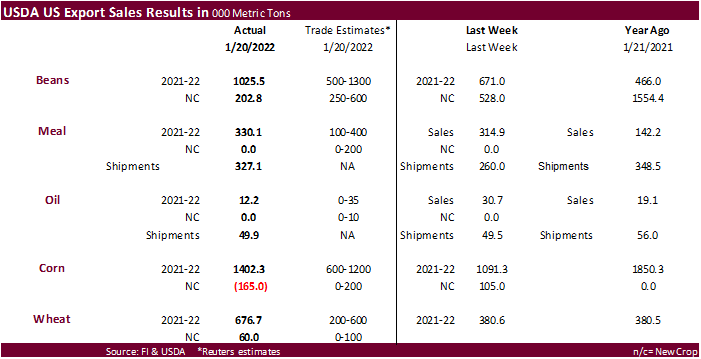

Macros
85
Counterparties Take $1.584 Tln At Fed Reverse Repo Op. (prev $1.613 Tln, 79 Bids)
US
GDP Annualized (Q/Q) Q4 A: 6.9% (exp 5.5%; prev 2.3%)
US
Core PCE (Q/Q) Q4 A: 4.9% (exp 4.9%; prev 4.6%)
–
Personal Consumption Q4 A: 3.3% (exp 3.4%; prev 2.0%)
–
GDP Price Index Q4 A: 6.9% (exp 6.0%; prev 6.0%)
US
Initial Jobless Claims Jan-22: 260K (exp 265K; R prev 290K)
–
Continuing Claims Jan-15: 1675K (exp 1653K; R prev 1624K)
US
Durables Goods Orders Dec P: -0.9% (exp -0.5%; R prev 3.2%)
–
Durables Ex-Transportation Dec P: 0.4% (exp 0.3%; R prev 1.1%)
–
Cap Good Orders Nondef Ex-Air Dec P: 0.0% (exp 0.4%; R prev 0.3%)
–
Cap Goods Ship Nondef Ex-Air Dec P: 1.3% (exp 0.5%; R prev 0.4%)
US
Pending Home Sales (M/M) Dec: -3.8% (est -0.4%; prev R -2.3%)
–
Pending Home Sales NSA (Y/Y): -6.6% (est -4.0%; prev 0.2%)
Corn
·
Bloomberg: U.S. Natural Gas for February Delivery Jumps as Much as 72%
·
Argentina’s late planted corn crop appears to be in ok shape according to selected articles, yet the proportion of crop conditions by the BA Grains Exchange suggest soybeans are in better shape. Several forecasters are looking
for ENSO to ease next month. Scattered showers are expected in the north, west, and west-central regions over the next week. The southern areas will dry down.

·
USDA Attaché: Argentina corn production 51 million tons, 3 million below USDA.
https://apps.fas.usda.gov/newgainapi/api/Report/DownloadReportByFileName?fileName=Grain%20and%20Feed%20Update_Buenos%20Aires_Argentina_01-20-2022
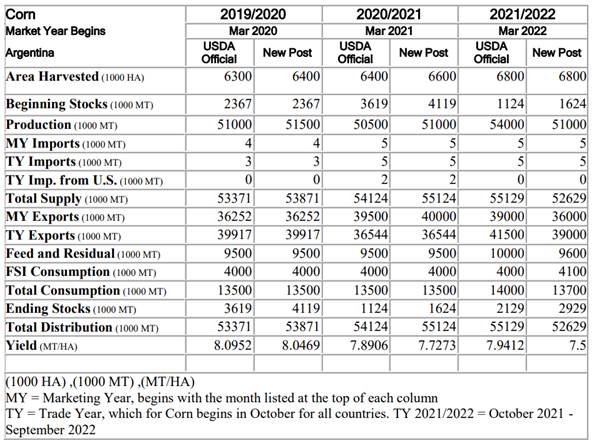
·
Funds sold an estimated net 5,000 contracts.
·
USDA export sales for corn of 1.4 million tons were above expectations.
·
South Africa’s corn area this planting season was seen 5.3% smaller than last year to 2,609,700 hectares, down from 2,755,400 hectares in 2021. The CEC forecast a 6.9% drop for white maize, and a 2.8% drop for yellow maize.
·
Bloomberg: U.S. cattle herd as of Jan. 1 seen falling by over a million head to 92.5m, the lowest level in six years, according to the avg in a Bloomberg survey of four analysts.
·
Taiwan has been by a shortage of eggs due to high feed prices and colder than normal temperatures.
Export
developments.
None
reported
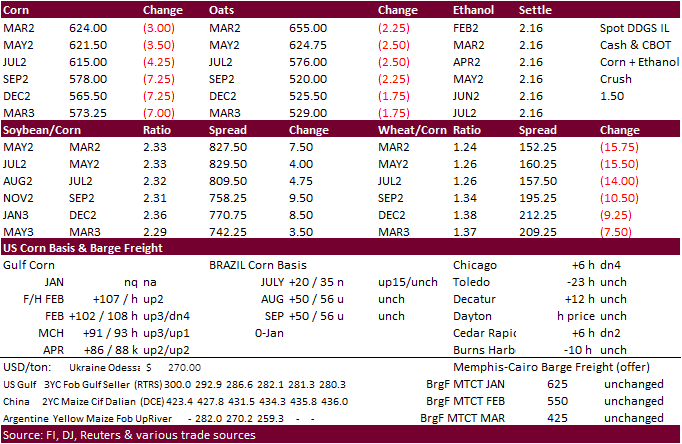
Updated
1/21/22
March
corn is seen in a $5.90 to $6.35
·
Soybeans and meal traded two-sided, with both markets ending higher (soybeans near 7-month high). A sharply higher USD limited gains. March soybeans hit a new contract earlier of $1456.50. Previous high was 14.4550 from June 7th.
March Soyoil hit a new contract high of 64.86. Previous high was 64.68 from June 10th. Soybean oil held gains on Thursday, at least in the front months (bull spreading), from record palm oil futures and very good USDA export shipments.
·
US crush margins firmed. USDA export sales product shipments were very good last week via the export sales report.
·
Funds bought an estimated net 4,000 soybeans, bought 2,000 soybean meal and bought 2,000 soybean oil.
·
During the morning trade talk of a Brazil port strike circulated. Later we heard it was for one day for a few ports in Santos.
·
USDA soybean oil shipments for the week ending January 20 were excellent at 49,876 tons, up from 49,492 tons week earlier (combined 99,368 tons). Last time we saw a combined two-week total amounting this large was back during
the February 19 through the March 4 period of 105,303 tons. 33,000 tons of the 49,876 tons were shipped to India last week. The previous week (ending Jan 13) included 15,500 tons to Guatemala and 15,000 tons to South Korea. 2021-22 accumulated US soybean
oil shipments are running at 304,507 tons, down from 339,980 tons a year earlier.
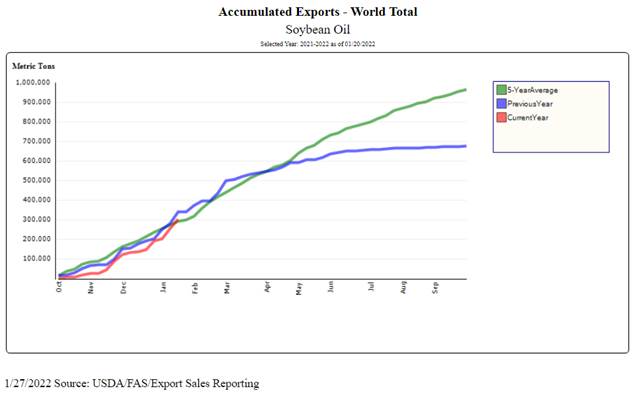
·
April Malaysian palm futures traded higher by 115 ringgit to 5,444, a new record high. It opened higher for their third overnight session, last 5486, up 42.
·
Indonesia announced all cooking oil producers will be required to sell 20% of their planned export to the domestic market. The mandatory portion of palm oil to be sold in the domestic market will be set at a maximum price of
9,300 rupiah ($0.6465) per kg for crude palm oil and 10,300 rupiah per kg for olein.
·
We are hearing the US Gulf is maxed out for shipments for corn wheat and soybeans.
·
CNGOIC reported soybean crush last week increased about 250,000 tons to 2.2 million, and stocks fell 300,000 tons to 3.6 million tons. China soybean meal stocks are very tight at less than 300,000 tons.
·
Brazil’s Derel estimated soybean production in Paraná at 12.83 million tons for 2021-22, down from 13.1 million in early January. This would be down 35% from 19.8 million tons last season and lowest in ten years.
·
Abiove estimates Brazil soybean exports at 86.9 million tons (91.1 previous) with a 135.8 million ton production estimate (down 4.2MMT from previous). They see crush at 48 million tons, a record and unchanged from previous. Yesterday
Safras & Mercado estimated Brazil’s 2022 soybean exports at 85.5 million tons, down from 90 million tons previously. Safras last estimated Brazil production at 132.3 million tons.
·
USDA in January projected Brazil soybean production at 90 million tons for the Feb 2022-Jan 2023 local crop year. Safras sees the crush at 47.5 million tons, above 46.5 million tons year ago.
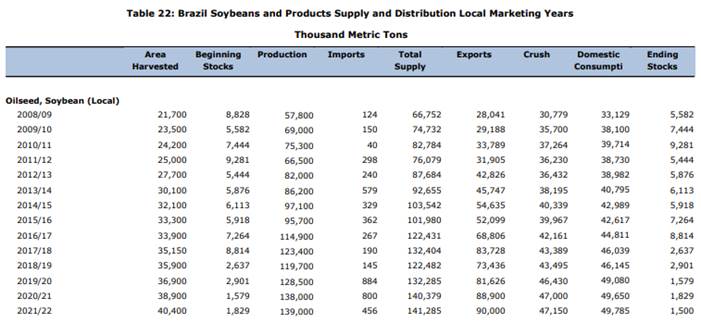
Source:
USDA
·
USDA Attaché: Argentina soybean production 46.5 million tons, 3 million below USDA.
https://apps.fas.usda.gov/newgainapi/api/Report/DownloadReportByFileName?fileName=Oilseeds%20and%20Products%20Update_Buenos%20Aires_Argentina_01-04-2022
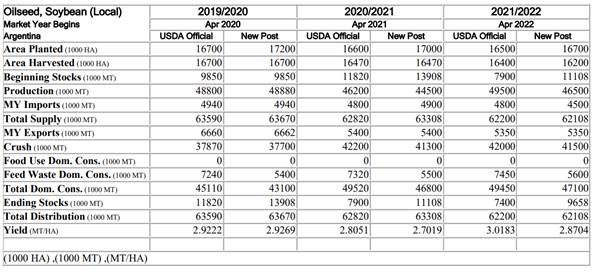
We
had to discontinue reporting our China cash sheet/quotes as our data service provider shut off access to local China city quotes. China crush margins are still positive according to Reuters calculations.
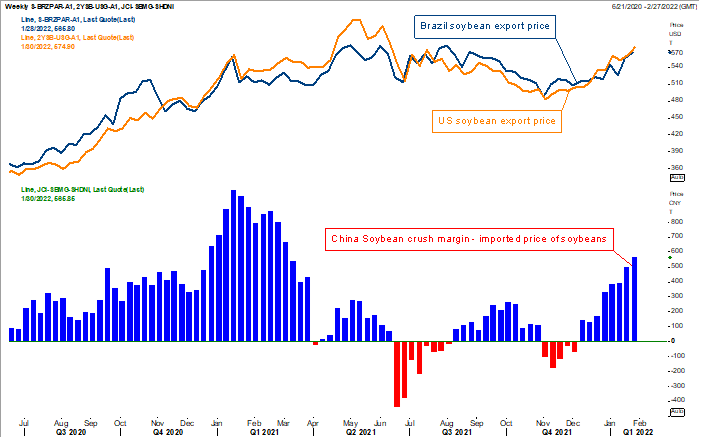
Source:
Reuters and FI
Export
Developments
·
South Korea’s NOFI group bought about 60,000 tons of South American soybean meal at an estimated $548.50 a ton c&f for arrival in South Korea around May 3.
·
Turkey’s state grain board TMO seeks about 6,000 tons of crude sunflower oil on Jan. 28 for shipment between Feb. 8 and Feb. 25.
Indonesia
domestic use of palm oil accounts for about 35 percent of production.
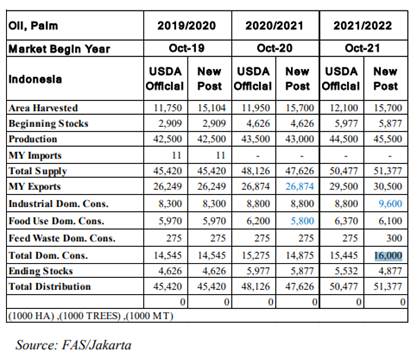
Palm
and SBO converted to USD/ton versus ICE Brent Crude
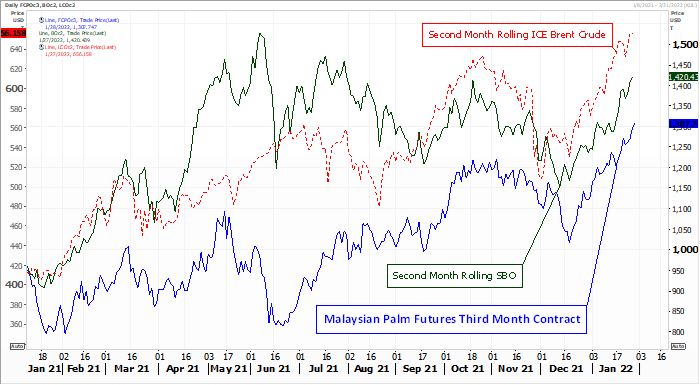
Source:
Reuters and FI
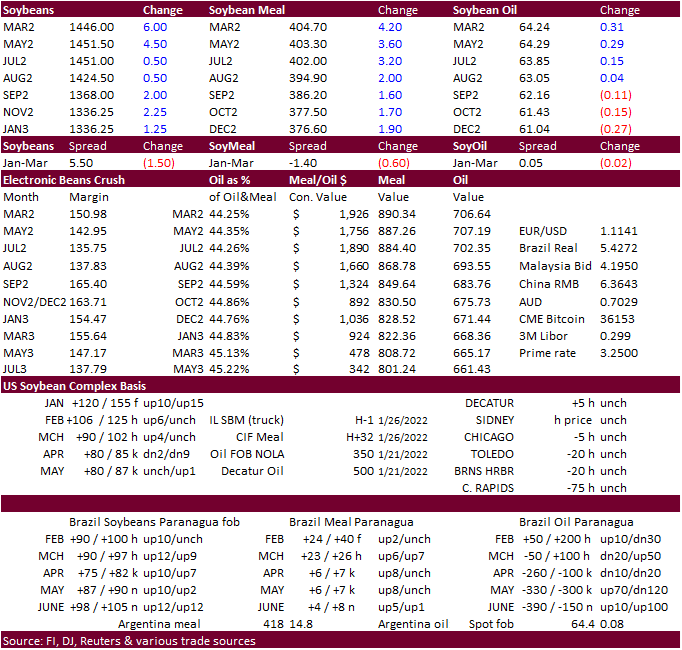
Updated
1/26/22
Soybeans
– March $13.75-$15.00
Soybean
meal – March $370-$435
Soybean
oil – March 59.50-65.00
·
US wheat futures ended lower, this time led by KC type wheat, on follow through selling and the USD screaming higher. Ongoing concerns over Ukraine/Russia tensions and good export sales did little to limit losses. After the close
Egypt announced they seek wheat for March 5-15 shipment.
·
Funds sold an estimated net 10,000 Chicago wheat contracts.
·
USDA export sales for all wheat of 676,700 tons were above expectations, and a marketing year high.
·
EU wheat basis the March position was down 4.00 euro at 277.25 euros.
·
The European Commission its soft wheat production estimate to 130.5 million tons from 130.6 million and left unchanged EU wheat exports at 32.0 million tons.
·
Egypt’s GASC seeks wheat for March 5-15 shipment.
·
Japan bought 25,431 tons out of the 47,841 tons sought of food wheat from Australia. Original details as follows.

-
Jordan
seeks 120,000 tons of feed barley on February 2. -
Three
groups from the Philippines are seeking feed wheat for April-May, April-October and/or May-July shipment.
·
Results awaited: Iran’s SLAL seeks 60,000 tons of barley, 60,000 tons of corn and 60,000 tons of soybean meal for Feb/Mar shipment.
·
Jordan seeks 120,000 tons of wheat on February 1 for July – August shipment.
Rice/Other
·
Results awaited: South Korea seeks 46,344 tons of rice from (mainly) China on Jan 27.
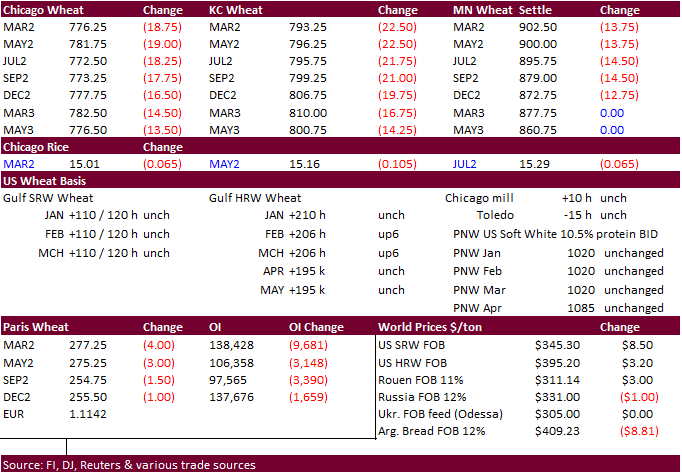
Updated
1/20/22
Chicago
March $7.50 to $8.30 range
KC
March $7.65 to $8.55 range
MN
March $8.75‐$10.00
U.S. EXPORT SALES FOR WEEK ENDING 1/20/2022
|
|
CURRENT MARKETING YEAR |
NEXT MARKETING YEAR |
||||||
|
COMMODITY |
NET SALES |
OUTSTANDING SALES |
WEEKLY EXPORTS |
ACCUMULATED EXPORTS |
NET SALES |
OUTSTANDING SALES |
||
|
CURRENT YEAR |
YEAR |
CURRENT YEAR |
YEAR |
|||||
|
|
THOUSAND METRIC TONS |
|||||||
|
WHEAT |
|
|
|
|
|
|
|
|
|
HRW |
279.2 |
2,165.8 |
1,356.2 |
130.2 |
4,614.1 |
6,001.4 |
15.0 |
39.5 |
|
SRW |
86.9 |
743.9 |
443.1 |
45.2 |
1,831.9 |
1,156.6 |
16.0 |
70.5 |
|
HRS |
199.9 |
1,361.7 |
1,894.3 |
111.3 |
3,265.8 |
4,513.2 |
15.0 |
31.0 |
|
WHITE |
110.1 |
819.6 |
2,398.1 |
73.7 |
2,234.4 |
3,349.8 |
14.0 |
42.0 |
|
DURUM |
0.4 |
54.6 |
168.0 |
0.4 |
113.1 |
489.8 |
0.0 |
33.0 |
|
TOTAL |
676.7 |
5,145.6 |
6,259.7 |
360.9 |
12,059.2 |
15,510.8 |
60.0 |
216.0 |
|
BARLEY |
0.0 |
18.0 |
13.3 |
0.0 |
12.5 |
17.2 |
0.0 |
0.0 |
|
CORN |
1,402.3 |
25,549.0 |
29,648.7 |
1,436.9 |
18,399.1 |
19,021.3 |
-165.0 |
1,452.0 |
|
SORGHUM |
328.5 |
4,172.0 |
3,358.6 |
73.9 |
1,962.8 |
2,398.7 |
0.0 |
53.0 |
|
SOYBEANS |
1,025.5 |
9,101.5 |
12,271.2 |
1,594.1 |
35,032.4 |
45,485.3 |
202.8 |
1,196.9 |
|
SOY MEAL |
330.1 |
2,938.4 |
2,845.9 |
327.1 |
3,937.2 |
4,052.3 |
-99.0 |
138.2 |
|
SOY OIL |
12.2 |
176.1 |
233.7 |
49.9 |
304.5 |
340.0 |
-0.1 |
0.2 |
|
RICE |
|
|
|
|
|
|
|
|
|
L G RGH |
31.2 |
172.2 |
294.9 |
37.1 |
637.8 |
838.7 |
0.0 |
0.0 |
|
M S RGH |
0.0 |
10.3 |
14.8 |
0.1 |
3.3 |
14.1 |
0.0 |
0.0 |
|
L G BRN |
5.2 |
10.3 |
10.3 |
0.5 |
28.0 |
23.1 |
0.0 |
0.0 |
|
M&S BR |
0.9 |
68.4 |
53.5 |
0.1 |
16.9 |
52.5 |
0.0 |
0.0 |
|
L G MLD |
24.8 |
92.9 |
75.3 |
10.7 |
418.1 |
326.9 |
0.0 |
0.0 |
|
M S MLD |
13.6 |
102.0 |
168.5 |
14.0 |
198.1 |
243.1 |
0.0 |
0.0 |
|
TOTAL |
75.7 |
456.0 |
617.4 |
62.5 |
1,302.1 |
1,498.4 |
0.0 |
0.0 |
|
COTTON |
|
THOUSAND RUNNING BALES |
||||||
|
UPLAND |
391.3 |
8,057.6 |
6,083.6 |
197.9 |
3,601.0 |
6,395.6 |
106.8 |
1,398.5 |
|
PIMA |
3.6 |
220.8 |
271.8 |
4.3 |
165.8 |
373.6 |
0.0 |
5.3 |
This summary is based on reports from exporters for the period January 14-20, 2022.
Wheat: Net
sales of 676,700 metric tons (MT) for 2021/2022–a marketing-year high–were up 78 percent from the previous week and up noticeably from the prior 4-week average. Increases were primarily for the Philippines (111,100 MT), Nigeria (110,300 MT, including decreases
of 46,000 MT), Japan (102,600 MT, including decreases of 400 MT), Mexico (80,100 MT, including decreases of 4,800 MT), and South Korea (78,000 MT, including decreases of 5,000 MT). Net sales of 60,000 MT for 2022/2023 were reported for Honduras (29,000 MT),
Japan (21,000 MT), and unknown destinations (10,000 MT). Exports of 360,900 MT were down 8 percent from the previous week, but up 21 percent from the prior 4-week average. The destinations were primarily to the Philippines (123,100 MT), Nigeria (50,300 MT),
Mexico (44,400 MT), Jamaica (29,500 MT), and Japan (29,300 MT).
Corn: Net
sales of 1,402,300 MT for 2021/2022 were up 29 percent from the previous week and 84 percent from the prior 4-week average. Increases primarily for Japan (563,700 MT, including 219,700 MT switched from unknown destinations and decreases of 3,100 MT), Mexico
(266,000 MT, including decreases of 44,200 MT), unknown destinations (102,100 MT, including 65,000 MT – late), Colombia (98,400 MT, including 41,000 MT switched from unknown destinations and decreases of 8,600 MT), and Guatemala (67,900 MT, including decreases
of 1,900 MT), were offset by reductions for Morocco (100 MT). Net sales reductions of 165,000 MT for 2022/2023 were reported for Japan (110,000 MT) and Mexico (55,000 MT). Exports of 1,436,900 MT–a marketing-year high–were up 11 percent from the previous
week and 36 percent from the prior 4-week average. The destinations were primarily to Japan (415,300 MT), Mexico (371,000 MT, including 27,300 MT – late), China (347,900 MT), Canada (104,600 MT), and Colombia (61,400 MT).
Optional Origin Sales: For 2021/2022,
new optional origin sales of 65,000 MT were reported for South Korea. Options were exercised to export 74,000 MT to unknown destinations from the United States. Decreases totaling 32,000 MT were reported for Italy. The current outstanding balance of
342,300 MT is for unknown destinations (235,000 MT), South Korea (65,000 MT), Italy (33,300 MT), and Saudi Arabia (9,000 MT).
Late Reporting: For
2021/2022, net sales totaling 65,000 MT of corn were reported late for unknown destinations. Exports totaling 27,300 MT of corn were reported late to Mexico.
Barley: No net sales or exports were reported for the week.
Sorghum: Net sales of 328,500 MT for 2021/2022 were down
31 percent from the previous week, but up 87 percent from the prior 4-week average. Increases were reported for China (202,500 MT) and unknown destinations (126,000 MT). Exports of 73,900 MT were down 46 percent from the previous week and 44 percent from
the prior 4-week average. The destinations were to China (73,200 MT) and Mexico (700 MT).
Rice: Net sales of 75,700 MT for 2021/2022 were up 77 percent
from the previous week and 88 percent from the prior 4-week average. Increases were primarily for Mexico (25,500 MT), Haiti (15,100 MT, including decreases of 100 MT), Japan (12,000 MT), Canada (9,800 MT), and Guatemala (6,700 MT). Exports of 62,500 MT were
up noticeably from the previous week and from the prior 4-week average. The destinations were primarily to Mexico (29,600 MT), Japan (13,000 MT), Guatemala (9,400 MT), Haiti (7,100 MT), and Canada (2,100 MT).
Exports for Own Account: For 2021/2022, the current exports
for own account outstanding balance is 100 MT, all Canada.
Soybeans: Net sales of 1,025,500 MT for 2021/2022 were up
53 percent from the previous week and 77 percent from the prior 4-week average. Increases primarily for China (540,200 MT, including 132,000 MT switched from unknown destinations and decreases of 2,600 MT), Mexico (345,300 MT, including decreases of 67,200
MT), Spain (105,900 MT, including 97,000 MT switched from unknown destinations), the Netherlands (84,200 MT, including 80,000 MT switched from unknown destinations and decreases 1,800 MT), and Japan (79,000 MT, including 70,500 MT switched from unknown destinations
and decreases of 100 MT), were offset by reductions primarily for unknown destinations (405,800 MT). Net sales of 202,800 MT for 2022/2023 were reported for China (198,000 MT) and Japan (4,800 MT). Exports of 1,594,100 MT were down 12 percent from the previous
week, but up 1 percent from the prior 4-week average. The destinations were primarily to China (844,400 MT, including 138,300 MT – late), Mexico (111,200 MT), Spain (105,900 MT), Japan (89,900 MT), and the Netherlands (84,200 MT).
Export for Own Account: For 2021/2022, the current exports
for own account outstanding balance is 3,000 MT, all Canada.
Late Reporting: For
2021/2022, export totaling 138,300 MT of soybeans were reported late to China.
Soybean Cake and Meal: Net sales of 330,100 MT for 2021/2022
were up 5 percent from the previous week and up noticeably from the prior 4-week average. Increases primarily for Ecuador (70,900 MT), Vietnam (50,000 MT switched from Thailand), the Philippines (48,800 MT), Honduras (37,000 MT), and Guatemala (36,700 MT),
were offset by reductions primarily for Thailand (53,000 MT) and Mexico (44,300 MT). Net sales reductions of 99,000 MT for 2022/2023 resulting in increases for Canada (600 MT) and Japan (400 MT), were more than offset by reductions for Spain (100,000 MT). Exports
of 327,100 MT were up 26 percent from the previous week and 51 percent from the prior 4-week average. The destinations were primarily to Ecuador (70,300 MT), the Philippines (51,700 MT), Denmark (48,700 MT), Thailand (47,000 MT), and Morocco (29,700 MT).
Optional Origin Sales: For 2021/2022, the current outstanding
balance of 50,000 MT is for Venezuela.
Soybean Oil: Net sales of 12,200 MT for 2021/2022 were down
61 percent from the previous week, but up 22 percent from the prior 4-week average. Increases were primarily for Mexico (5,000 MT), Venezuela (3,000 MT), the Dominican Republic (2,000 MT), and Canada (1,700 MT). Total net sales reductions of 100 MT for 2022/2023
were for Canada. Exports of 49,900 MT–a marketing-year high–were up 1 percent from the previous week and 72 percent from the prior 4-week average. The destinations were primarily to India (33,000 MT), Colombia (7,100 MT), the Dominican Republic (5,000
MT), Jamaica (3,500 MT), and Mexico (1,000 MT).
Cotton: Net
sales of 391,300 RB for 2021/2022 were up 43 percent from the previous week and 55 percent from the prior 4-week average. Increases primarily for Vietnam (132,900 RB, including 600 RB switched from South Korea and 400 RB switched from Japan), India (62,400
RB, including decreases of 3,500 RB), China (58,200 RB, including 8,400 RB switched from unknown destinations and decreases of 2,200 RB), Bangladesh (39,400 RB), and Pakistan (37,300 RB), were offset by reductions for unknown destinations (8,400 RB). Net
sales of 106,800 RB for 2022/2023 were primarily for Indonesia (33,900 RB), Pakistan (22,900 RB), Guatemala (14,000 RB), Turkey (13,600 RB), and Honduras (9,700 RB). Exports of 197,900 RB were unchanged from the previous week, but up 25 percent from the prior
4-week average. The destinations were primarily to China (64,200 RB), Turkey (23,800 RB), Vietnam (23,300 RB), Pakistan (20,300 RB), and Mexico (15,700 RB). Net sales of Pima totaling 3,600 RB were down 5 percent from the previous week and 19 percent from
the prior 4-week average. Increases were reported for India (1,700 RB), Vietnam (800 RB), China (800 RB), Japan (200 RB), and Mexico (100 RB). Exports of 4,300 RB were down 43 percent from the previous week and 44 percent from the prior 4-week average. The
destinations were primarily to India (1,700 RB), Peru (1,300 RB), China (700 RB), and Egypt (400 RB).
Optional Origin Sales: For 2021/2022, the current outstanding
balance of 61,600 RB is for Vietnam (52,800 RB) and Pakistan (8,800 RB).
Exports for Own Account: For 2021/2022, the current exports
for own account outstanding balance is 100 RB, all Vietnam.
Hides and Skins: Net
sales of 592,900 pieces for 2022, primarily for China (351,800 whole cattle hides, including 10,600 whole cattle hides switched from Cambodia and decreases of 6,200 pieces), South Korea (72,700 whole cattle hides, including decreases of 3,200 pieces), Mexico
(54,400 whole cattle hides, including decreases of 500 pieces), Thailand (28,000 whole cattle hides, including decreases of 1,800 pieces), and Brazil (23,800 whole cattle hides, including decreases of 700 pieces), were offset by reductions for Cambodia (10,600
pieces). In addition, total net sales of 7,000 calf skins were reported for Italy. Exports of 420,900 pieces were primarily to China (258,300 pieces), South Korea (60,200 pieces), Mexico (37,100 pieces), Thailand (33,800 pieces), and Taiwan (10,600 pieces). In
addition, exports of 3,200 were to Italy (1,800 calf skins and 1,400 kip skins).
Net sales of 343,400 wet blues for 2022 were primarily for Vietnam (145,400 unsplit, including decreases of 200 unsplit), Italy
(96,500 unsplit and 100 grain splits), China (70,800 unsplit, including decreases of 100 unsplit), and Mexico (16,800 grain splits and 4,300 unsplit). Exports of 169,900 wet blues were primarily to Vietnam (72,300 unsplit), China (50,800 unsplit), Italy 28,700
unsplit and 3,200 grain splits), Mexico (6,000 grain splits and 3,500 unsplit), and South Korea (3,200 grain splits). Net sales of 1,186,300 splits for 2022 were reported for Vietnam (1,184,800 pounds, including decreases of 16,000 pounds) and China (1,500
pounds, including decreases of 1,300 pounds). Exports of 607,500 pounds were primarily to Vietnam (483,600 pounds).
Beef: Net sales of 14,300 MT for 2022 were primarily for
South Korea (6,200 MT, including decreases of 400 MT), Japan (3,900 MT, including decreases of 500 MT), Mexico (600 MT), China (600 MT, including decreases of 900 MT), and Indonesia (600 MT). Exports of 14,300 MT were primarily to Japan (4,100 MT), South
Korea (3,900 MT), China (1,900 MT), Taiwan (1,300 MT), and Mexico (900 MT).
Pork: Net sales of 49,100 MT for 2022, primarily for Mexico
(17,300 MT, including decreases of 300 MT), China (16,900 MT, including decreases of 200 MT), Canada (3,000 MT, including decreases of 500 MT), Japan (2,700 MT, including decreases of 400 MT), and South Korea (2,600 MT, including decreases of 300 MT), were
offset by reductions for Trinidad and Tobago (100 MT), Australia (100 MT), and Guatemala (100 MT). Exports of 30,700 MT were primarily to Mexico (16,000 MT), Japan (3,600 MT), China (3,600 MT), South Korea (2,000 MT), and Canada (1,400 MT).
Terry Reilly
Senior Commodity Analyst – Grain and Oilseeds
Futures International
One Lincoln Center
18 W 140 Butterfield Rd.
Oakbrook Terrace, Il. 60181
W: 312.604.1366
ICE IM:
treilly1
Skype: fi.treilly

Trading of futures, options, swaps and other derivatives is risky and is not suitable for all persons. All of these investment products are leveraged, and you can lose more than your initial deposit. Each investment product is offered
only to and from jurisdictions where solicitation and sale are lawful, and in accordance with applicable laws and regulations in such jurisdiction. The information provided here should not be relied upon as a substitute for independent research before making
your investment decisions. Futures International, LLC is merely providing this information for your general information and the information does not take into account any particular individual’s investment objectives, financial situation, or needs. All investors
should obtain advice based on their unique situation before making any investment decision. The contents of this communication and any attachments are for informational purposes only and under no circumstances should they be construed as an offer to buy or
sell, or a solicitation to buy or sell any future, option, swap or other derivative. The sources for the information and any opinions in this communication are believed to be reliable, but Futures International, LLC does not warrant or guarantee the accuracy
of such information or opinions. Futures International, LLC and its principals and employees may take positions different from any positions described in this communication. Past results are not necessarily indicative of future results.
